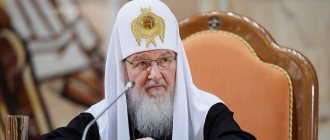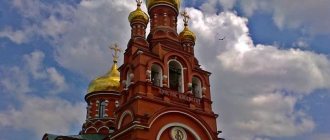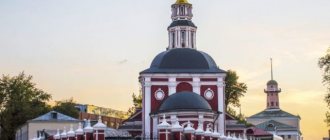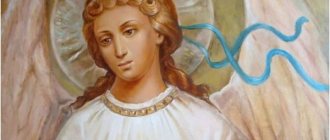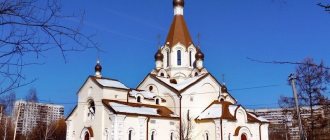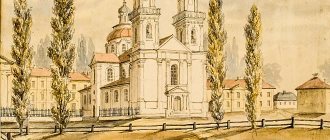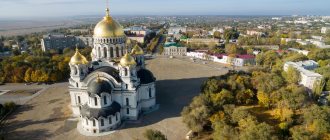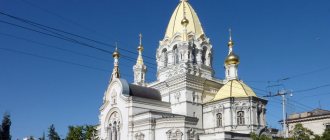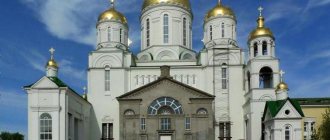| Novosibirsk Ascension Cathedral |
Cathedral in honor of the Ascension of the Lord in Novosibirsk,
Novosibirsk diocese.
- Throne: Ascension of the Lord
- Address: Russia, Novosibirsk, st. Sovetskaya, 91
- On the map: Yandex.Map, Google map
The original modest wooden temple was completely transformed as a result of gradual reconstruction in 1944-1988 and became a spacious stone building, painted inside and beautifully decorated outside.
The cathedral has seven gilded domes. A cross is raised above the entrance on the western side. The spacious hipped bell tower is single-tiered, square in plan with wide openings in which small and medium-sized bells hang. A large bell—annunciative—is placed in the center of the belfry. Three canopies, one above the other, rising to the bell tower, create the impression of a protruding entrance. In the cathedral fence there is a baptismal room with a temple in honor of the Epiphany of the Lord, where baptism is performed daily. The cathedral complex includes a chapel and an administrative building
Story
A church was built in honor of the Ascension of the Lord in Novonikolaevsk (now Novosibirsk) with the permission of the Tomsk diocesan authorities through the diligence of the construction committee. On April 6, 1913, Novonikolaevsk dean archpriest Nikolai Zavadovsky consecrated the newly built church, popularly named Turukhansky. Initially it was single-altar, wooden, with a bell tower in one link, covered with iron. Located on the northern outskirts of the city, the temple was one of the poorest in the city, with a staff of one priest and one psalm-reader. The parish consisted of poor laborers and artisans, among whom there were many foreigners, people of other faiths, and sectarianism was widely promoted. At the parish of the Ascension Church there were three primary parish schools of the Ministry of Public Education.
In 1925, a chapel was built in the name of St. Nicholas the Wonderworker. In 1938-1939 the temple was closed. The city authorities used the church as a grain warehouse.
In April 1944, services resumed in the Church of the Ascension. The temple did not require urgent repairs - the iconostasis, altars and candlesticks were preserved - and on Great Wednesday of that year its minor consecration took place. On Easter, not only the temple was overcrowded, but also its entire vast enclosure. Since that time, the Novosibirsk bishop has served in the church. For the needs of the army and the front in the period from 1944 to 1945, 1,686 thousand rubles were received from the Ascension Church. The archpastor spent a lot of effort and money on the restoration and improvement of the temple. At the end of March 1946, the bells were raised. In the same year, through his efforts, the construction of a new chapel began, and on December 28, 1947, Archbishop Bartholomew solemnly consecrated the new chapel in honor of St. Seraphim of Sarov. The Ascension Church was elevated to the rank of cathedral in 1947.
With the blessing of Metropolitan Nestor, a tombstone was built over the grave of Bishop Bartholomew in the cathedral, and through the efforts of Archbishop Paul, a stone baptismal church was being built to replace the dilapidated wooden one.
By the 1970s, the wooden cathedral had fallen into disrepair. On February 12, 1971, a circus was opened next to the cathedral, as a result of which the cathedral territory lost one of its two entrances, and the temple itself found itself in a lowland. Bishop Gideon, who arrived at the Novosibirsk see in 1971, immediately became concerned about the condition of the building. In 1974, the western part of the building was reconstructed, the vestibule was enlarged, and the columns inside the cathedral were replaced. After construction, the new brick walls were hidden under wooden siding to maintain the overall appearance of the wooden temple. In 1976, the walls of all three altars were one by one dismantled and replaced with brick ones, and by 1979 the lower church was built in honor of the Holy Blessed Prince Alexander Nevsky and Gideon the Forefather. Further, with the blessing of Metropolitan Gideon, a complete reconstruction of the Ascension Cathedral was carried out under the leadership of the rector of the church, Archpriest Dimitry Budko. The reconstruction was timed to coincide with the celebration of the 1000th anniversary of the Baptism of Rus'. The temple reconstruction project was carried out by Novosibirsk architect V.P. Avksentyuk. By August 1988, construction work was completely completed. And although during the reconstruction of the cathedral, government authorities did not give permission to make it taller and more spacious, as the church leadership and builders wanted, it became the adornment of Novosibirsk. Around 1986, a Sunday school was opened at the temple.
| Chapel of the Siberian Saints at the Novosibirsk Ascension Cathedral. Photo by Oleg Nesterov |
According to the design of the architect B. A. Zakharov, a chapel in honor of All Saints who shone in the land of Siberia and, in 1998, an administrative building were built at the cathedral in 1996.
In 1999, to celebrate the 75th anniversary of the Novosibirsk diocese, the main iconostasis of the temple was restored and re-gilded. In the Ascension Cathedral there is a bishop's choir, a children's choir (junior group and senior group) and the St. Macarius youth choir. In 1995, a Mercy Center was established at the cathedral in the name of the holy great martyr and healer Panteleimon. An Orthodox video studio has been organized. On the third floor of the new administrative building there is a parish library of spiritual literature for all residents of the city, as well as the library of the Novosibirsk Orthodox Theological Institute.
On May 23, 2002, Patriarch Alexy II served an all-night vigil in the cathedral, at which the glorification of the new Siberian holy martyrs Nicholas (Ermolov) and Innocent (Kikin) took place.
Statistics
- April 1 - July 1, 1946 - on regular Sundays, up to 900 people visit, on weekdays 250-300, on Easter up to 5000, on Trinity Day up to 4000, on patronal feasts approx. 3000 [1]
| Novosibirsk Ascension Cathedral |
Architect and exterior decoration of the cathedral
Reconstruction of the temple, superbly executed according to the design of the architect V.P. Avksentyuk, noted as the best work of Novosibirsk architects and awarded a high award - a 1st degree diploma, as well as a medal of the Russian Union of Architects.
The style of the cathedral can be defined as classical, with characteristic elements of folk architecture:
- gable roofs;
- scaly lining;
- ornamental design of doors;
- intricate gutters;
- round dormer windows;
- decoration of window openings in the form of kokoshniks.
The rebuilt temple today is crowned with 7 gilded domes, and a cross also rises above the western entrance. The cathedral has a small height, but it looks majestic and proportional, and in conjunction with the hipped single-tier bell tower it makes a very harmonious impression.
After restoration, all the walls were carefully plastered and painted, and a mosaic panel with the image of the Virgin Mary was installed at the entrance. The walls of the temple facades are also decorated with mosaics.
Shrines
- Icon of St. Nicholas the Wonderworker with a particle of his relics
- Icon of the Great Martyr. Panteleimon the Healer, with a particle of relics
- Icon of St. Seraphim of Sarov, with a particle of relics
- Icon of St. Ambrose of Optina with a particle of relics, in the altar of the Seraphim chapel
- Icon of St. Innocent, Metropolitan of Moscow and Kolomna with a particle of relics, gift of Patriarch Alexy II, in the chapel
- Life-giving spring, icon of the Mother of God in the lower church
- Ark with particles of the relics of many saints in the altar of the Seraphim chapel
- Softening Evil Hearts, Icon of the Mother of God
- Chernigov Icon of the Mother of God
- Burial of Metropolitan Novosibirsk Bartholomew (Gorodtsov) in the Serafimovsky chapel
Mentors
History of the mentors and abbots of the temple:
- The first rector of the Ascension Church was priest Gabriel Nikanorovich Lebedev, who served here from 1913 to 1915.
- The priest Vasily Andreevich Kurkov, appointed in his place, became his successor.
- In 1924, in connection with the formation of the Novonikolaevsk diocese, an episcopal see was formed here, headed by the 1st bishop, Metropolitan Nikifor Astashevsky.
- In 1937, Archbishop Sergius Vasilkov became his successor, who was shot that same year along with the laity and Archpriest Vasily Kurkov.
- In 1943-56, the administration of the diocese belonged to Metropolitan Bartholomew Gorodtsev, who found his rest here. A tombstone has been placed over his grave.
- Metropolitan Nestor Anismov headed the diocesan see in the period 1956-58.
- Donat Shchegolev became the next archbishop until 1961.
- Bishop Leonty Bondar headed the department during 1961-63.
- Archbishop Cassian of Yaroslavl led the diocese from 1963 to 64.
- The next bishop until 1972 was Pavel Golyshev.
- The most sacred Bishop Gideon Dokukin, who headed the department from 1972 to 1993, carried out a global reconstruction of the temple.
- Metropolitan Tikhon Emelyanov had to lead the diocese twice: in the period 1990-95 and 2000-18.
- Bishop Sergius Sokolov ruled the diocese from 1995 to 2000.
- The current Metropolitan Nikodim Chibisov has been ruling the Novosibirsk and Berd diocese since 2022.
See also: Burgas. Sights, photos of the city, interesting things to see, recreation
Service schedule, operating hours
The Ascension Cathedral in Novosibirsk is open every day.
Divine services are held daily according to the following schedule:
| Service name | Weekdays of the week | Sundays and holidays |
| Divine Liturgy | 9-00 | 7 and 10 o'clock |
| Sacrament of Confession | 8-30 | 6-30 and 9-30 hours. |
| Evening service | 17-00 | 17-00 |
| Sacraments of baptism | From Wednesday to Saturday from 12 to 16 hours. | from 10 a.m. to 4 p.m. |
| Wedding, except days of church fasts | Mondays, Wednesdays and Fridays at 13:00 and 16:00 | 13-00 and 16-00 hours. |
On Sundays and Thursdays after the evening service, akathists are chanted.
Rules for visiting the temple
A visit to an Orthodox cathedral implies respect for the feelings of believers and visitors to the temple:
- Before entering the church, you should turn off the sound notification of your mobile device.
When entering the Ascension Cathedral, Novosibirsk, it is important to turn off your phone or switch it to silent mode.
- When entering the building of an Orthodox church, it is customary for the male part of the population to bare their heads, and for women, on the contrary, to cover their hair with a scarf.
- Clothing must be appropriate to the gender of the visitor, decent and modest. It is not allowed to enter in shorts and T-shirts, a strong neckline or a mini skirt. You cannot enter the church barefoot.
- It is not customary to have loud conversations on the temple grounds, to disturb, to push, or to take photographs of worshipers.
- Silence and cleanliness must be maintained.
- Children should not be left unattended, nor should they be allowed to run, scream or play around in the temple. If a baby cries during a service, it is advisable to take him out and calm him down outside the church.
- It is prohibited to enter the temple premises with pets.
- It is not customary to bring food and ice cream to church, drink juices or chew gum.
- You should not enter the temple with large bags.
- It is prohibited to attend church under the influence of alcohol or drugs.
Information for visitors
The Ascension Cathedral in Novosibirsk is open to everyone every day, completely free of charge. On weekdays, the cathedral opens at 7-30 am, on Sundays and holidays at 5-30 am. The temple closes with the departure of the last visitor after the end of the evening service.
See also: Intercession Monastery Suzdal. Photos, schedule, history
Every day from 12 to 17 o'clock a clergyman is on duty in the temple, who can advise and answer all the parishioners' questions.
There is a charity center at the cathedral, which provides all possible assistance to all those in need, and collects funds and material donations from citizens. The parishioners themselves actively participate in charitable activities.
Also, the center’s staff regularly visit patients in the psychoneurological department and orphans of the orphanage, conduct catechetical conversations and communicate on pressing issues in an individual form. Interesting congratulations and small gifts are prepared for the holidays.
The church organizes social work with teenagers at the drug treatment clinic, where general and individual educational conversations, holiday concerts, and joint events are also held. The Mercy Center provides regular assistance to lonely and seriously ill parishioners of the temple.
In the youth club, which has existed at the church for the second decade, young activists of the parish, under the leadership of the priest, conduct various events of a spiritual and social orientation. Meetings are held every week on Sundays at the parish school.
The children take part in round tables and discussion meetings on issues that are relevant to them, prepare lectures, invite specialists and interesting people for informal communication, and organize musical meetings and concerts.
Club members organize joint viewings of feature films and reading books, followed by discussion, studying Christian literature with interpretations of the Holy Fathers. The youth club also hosts interesting pilgrimage and labor trips.
The club's work also goes in the sports direction. Mini-football tournaments are held, the organization and conduct of which is entirely the responsibility of the youth. The church runs a Sunday school for children and adults.
Children are accepted to different levels of education:
- Preschoolers aged 3 to 7 years.
- The primary level consists of 4 classes for children from 8 to 14 years old.
Classes are held throughout the school year on Sundays and include the study of sacred history and Orthodox services, temple history and the church calendar, the lives of the Saints, iconography and the basics of church reading. The school hosts colorful matinees and concerts, trips to holy places and trips to museums.
In addition, classes are held in the theater studio, artistic embroidery, and photography.
In Sunday school classes, adults read the Holy Scripture with interpretation, learn to read in Church Slavonic, study church hymns and liturgics, get acquainted with church history and Orthodox holidays. Training is provided in the form of various conversations, film lectures, and practical seminars. The training is free for everyone.
The church has a rich Orthodox library with a collection of more than 30 thousand volumes of spiritual literature. In the church shop you can buy crosses and candles, various icons, Orthodox books and specialized literature.
How to get there
The temple can be easily reached by public transport:
- By metro to Sibirskaya or Krasny Prospekt stations.
- To the Circus stop on bus routes No. 3, 13, 14, 18, 28, 32, 34, 35, 64, 75, 79, 97, 98, 189.
- On trolleybuses No. 2, 5, 13, 23, 29, 36.
- By minibuses No. 2, 13, 44a, 45, 1016, 1048, 1057, 1118, 1128, 1234.
It is convenient to get to the cathedral by private car, as there is a large free parking lot next to the temple. The Cathedral in honor of the Ascension of the Lord is not only an architectural decoration, but the main spiritual center in Novosibirsk, a favorite and visited place not only by citizens, but also by guests of the city.
